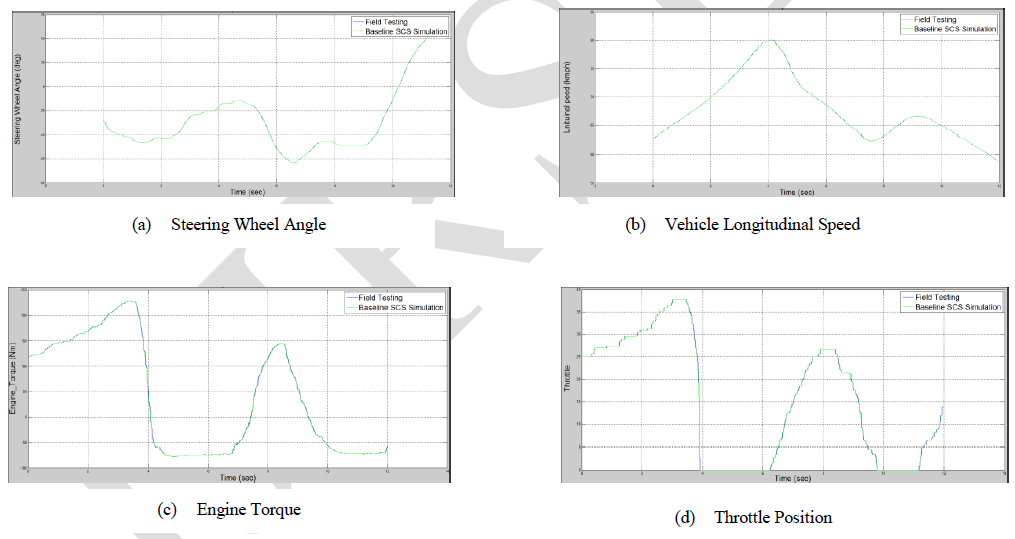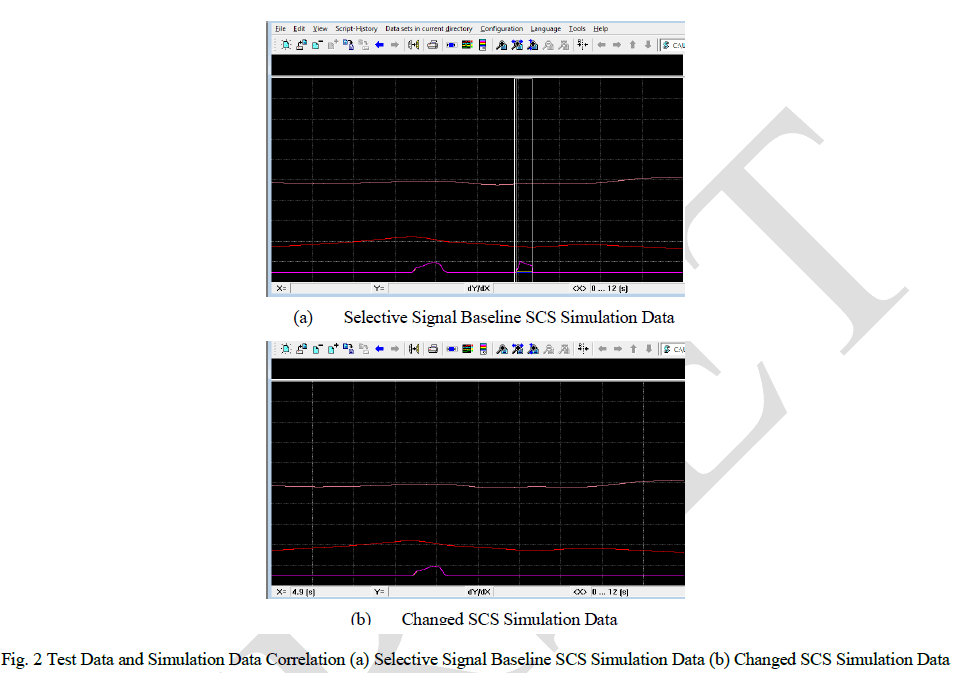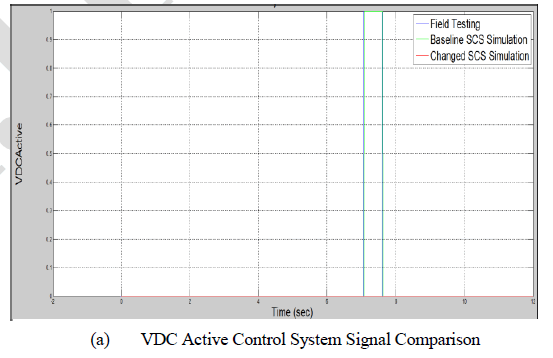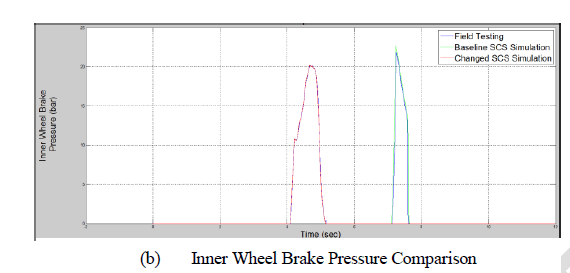ISSN ONLINE(2319-8753)PRINT(2347-6710)
ISSN ONLINE(2319-8753)PRINT(2347-6710)
Vinod S. Sakhala1, Dr.K.K.Dhande2, Prof.N.I.Jamadar3
|
| Related article at Pubmed, Scholar Google |
Visit for more related articles at International Journal of Innovative Research in Science, Engineering and Technology
This Study was performed during the winter of 2014 at Revi Winter Track in Arjeplog, Sweden on Snow & Ice. The thesis describes how to optimize the intervention of an Vehicle Dynamic Control (VDC) system for a sports car. The problem with VDC today is that it is very often defensively programmed and affects the feel when the car is driven, the intervention of VDC in this case is known as unwanted VDC intervention. What to be researched in this thesis is if an optimization of the program can be done that allows greater body slip without affecting the vehicle dynamics and stability in a negative way. Stability control system (SCS) simulation method which is the combination of virtual plus physical world is most suitable for testing and optimization of active stability control systems like VDC. Optimization and tuning procedure for mitigating the unwanted intervention of the control system during handling manoeuvre test has been achieved through SCS simulation. Field test procedures and results for SUV are described. The field test results are used to validate a simulation model which is then analyzed under severe maneuvering conditions to shed light on dynamic stability issues.
Keywords |
| Electronic Understeer Control (EUC), Stability Control System (SCS), Vehicle Dynamic Control (VDC), Electronic Stability Control (ESC), SIL, HIL, etc |
I. INTRODUCTION |
| For most of the automobile's history, engineers have focused on finding more and more ways to make vehicles stable. Recently, however, engineers have been implementing new technologies to help drivers avoid accidents altogether. The idea of accident avoidance is the foundation of active automotive stability safety. These active stability safety systems include features like brake assistance which can apply and control brake pressure for a driver if he or she hasn't responded to a situation quickly enough, or stability control programs which slows a car down when it's getting offset from its specified path this condition is known as understeer or oversteer [1]. An ESC system is an active stability safety technology designed to proactively help drivers to maintain control of their vehicles in situations where the vehicle is beginning to lose directional stability. Typically, an ESC system intervenes by utilizing computers to control individual wheel brakes, thereby helping to keep the vehicle headed in the direction intended by drivers. Keeping the vehicle on the road prevents runoff road crashes, which are the circumstances that lead to most single vehicle rollovers [2] |
| Over the past decade, the occurrence of rollover incidents in vehicle accidents has received much attention due to the increase in Sport Utility Vehicle (SUV) miles driven on the roadways and litigation claiming that engineers are to blame for designing unsafe vehicles, which causes number of vehicle crashes [3]. The best protection against crashes is to prevent them. For more than 30 years Bosch, Continental and many more organization have been developing active stability safety systems that significantly contribute to the reduction in the number of crashes, despite increasing traffic density. |
| Active stability safety systems such as the Antilock Braking System (ABS), Traction Control System (TCS) or the Electronic Stability Program (ESP) intervene before a crash occurs and prevent the rollover or any hazards situation [4]. The active safety control system functionalities have been designed based on the environment conditions; possible market for the vehicle (is it ice/snow, concrete road, sandy, muddy, etc.). And based on this environment the active safety system would performed, because of the setting (specified threshold values of the systems and relative vehicle parameters value) in the Electronic control unit (ECU) of the vehicle. Testing of the active systems usually begins in the virtual world where system performance and mathematical algorithms can be tested to ensure that everything works correctly. Once the systems are examined on a computer, real-world testing begins. |
| It is not possible to replicate the vehicle dynamic manoeuvres exactly during physical testing due to certain constrains such as human errors, environment conditions, external disturbance, etc. Even tuning of vehicle system parameters is costlier, time consuming and may or may not give appropriate results. On the other side vehicle manoeuvre can be made in virtual environment using MBD softwareâÃâ¬ÃŸs like CarMaker, Adams, CarSim, etc. These simulation softwareâÃâ¬ÃŸs tune the vehicle parameters precisely hence are cheaper and time saving. The results generated from virtual simulations are good accuracy than the physical testing. The main advantages of this approach include that the design can be evaluated before a prototype is available and virtual testing results can be easily validated by subsequent physical testing. [5] |
| At the time of field testing it would be mandatory to check the behaviour of the vehicle based on the installed control systems, whether the system working as expected or is there any issues with that. And if there is any issue has to be optimized in virtual simulations by tuning relative vehicle parameters [1,6]. In this study vehicle control system intervention during dynamic testing on snow surface has been discussed. A detailed description of the basic simulation model, including validation testing, and a discussion of the results for several parametric variation studies are provided in the following sections. |
II. RELATED WORK |
| There have been many published papers and books in the area of vehicle stability and dynamic testing & simulation. Dynamic testing plays a very important role in the area of vehicle stability and indirectly towards rollover propensity. |
| Dr. Hans-Peter Schöner , Dr. Stephen Neads, [1] investigated how dynamic manoeuvres can be run with precision using automatic driven vehicle for the purpose of safety control system testing. Also the process to integrate driving robot in test vehicle. Using these methodology risky manoeuvres can also be done precisely |
| Bock, Thomas; Maurer, Markus; Färber, Georg, [2]. The Vehicle in the Loop test setup has been developed for the safe, reproducible and resources-saving test of driver assistance functions for support in critical traffic situations. This setup combines the advantages of driving simulators and a real test vehicle by incorporating it into a traffic simulation. |
| R.Schram, [3] proposed a simple PC-crash programme from the Crash safety department of Chalmers University has been explained. Under this programme factors effecting the causation of accidents and incidents included. This is done using the standard simulation process. The effect of the input parameters like restitution, inter-vehicle friction, contact plane and point of impact after accident of the vehicle has been studied. |
| Shawn S. and Dave Fricke, [5] presented the virtual to physical coupling is accomplished in "real-time" allowing an accurate vehicle dynamics simulation to be conducted in a hybrid environment. Because of the limitations of the virtual and physical simulation alone, the new technology has been invented that is hybrid simulation it combines physical and virtual components, inputs and constraints to create a composite simulation system. |
| Huber, Bertold; Resch, Stefan, [6] presented evaluation and optimization of driver assistance systems like adaptive cruise control, brake assist, lateral control assistance system (Lane departure warning and Lane keeping warning) has been explained. Also this paper indicates the challenges, benefits and potential of the developed methods for testing driver assistance systems. |
| Viano, D. C. (2003), [7] determined the precipitating events leading to rollovers by analyzing real-world rollover crashes. The cases were divided into 3 categories defining the precipitating event leading to a rollover: 1) negotiating a curve at usually too high a speed, 2) drifting off the road, or 3) avoiding an obstacle in the traveling lane. Major reason behind this study was to identify vehicle maneuvers leading to rollovers. |
| Ali.Y. Ungoren and Huei Peng, [9] suggested the advancement in computer simulations make it possible to perform exhaustive design trials and evaluations before field testing, and promise to dramatically reduce development cost and cycle time. In this paper, a comprehensive simulation-based evaluation procedure is proposed, which combines standard evaluation manoeuvers. |
| The basic literature available for the vehicle stability testing and evaluation is provided in the books named as “Fundamental of Vehicle Dynamics” by Thomas Gillespie and “The Multi-Body System Approach to Vehicle Dynamics” [4] by Mike Blundell And Damian Harty. These books make our basic strong related to the vehicle dynamics. |
| Review of literature [1-9], various stability control system testing methods has been discussed. But each has its constraints SIL provide less accurate results, HIL and physical testing are costlier & time consuming and needs some kind of validation to finalize the outcome. Stability control system simulation is the perfect balance of SIL, HIL and Physical test which will provide effective solution. |
III. SIMULATION MODEL |
| Simulation has proven to be an efficient and accurate method for analysing and evaluating the dynamic behaviour of vehicles. As a part of the present effort, a simplified model that captures the essential vehicle dynamics associated with un-tripped rollover was developed and validated. |
IV. MODEL DEVLOPMENT |
| The primary dynamics that are of concern are those associated with the yaw and roll motions. And yaw and roll can be easily evaluated on the bases of dynamic testing of the vehicle. Prototype of the vehicle was manufactured. Sensors are installed on the vehicle. Based on the vehicle & surface/track on which testing was done, the stability control system (SCS) parameters file was developed. This parameter file was set as the first input to stability control system. Then the entire SCS software has installed on the vehicle, through electronic control unit (ECU). The signals which we wanted to record during field testing were given to SCS software. Field testing software was installed on the laptop and was connected to vehicle to record the measurement data (Manoeuvre & surface description, Signals) during field test. Test vehicle was equipped with necessary harnesses. |
| For the virtual simulation the virtual vehicle data set along with the tire information and the stability control system (VDC) was developed in the software package. In simulation process standard software packages were used for interaction with the control systems. For the development of active safety control system model Simulink was used. UNIVIEW was used for post processing simulation results. |
V. VIRTUAL SIMUALTION PROCESS VALIDATION |
| In order to validate the active control system described above, simulation results were compared with physical testing during Handling manoeuvre. Handling manoeuvres are the testing manoeuvres in which vehicles stability and performance is checked. This testing basically constitutes standard J-Turn, Fish-Hook and Double Lane Change manoeuvres. The Handling manoeuvre is a highly repeatable manoeuver as cited by many repudiated organisation and has been carried out to evaluate the roll stability control of the vehicle. Handling manoeuvre also called as Roll Stability Control (RSC) manoeuvre. Handling manoeuvres were carried out to evaluate the dynamic rollover propensity of the vehicle. In this kind of manoeuvers steering performance have more control on vehicle behaviour. |
| The simulation model contains a „virtual garageâÃâ¬ÃŸ that consists of „virtual vehicles,âÃâ¬ÃŸ each with a configuration to match those of experimental vehicle used in the physical dynamic testing. Parameters in the virtual garage, such as wheelbase, track width, roll stiffness, roll damping, roll centre location, brake characteristics are held constant. The virtual vehicles varied from one another by having different steering performance and total weight. |
| If there is any unexpected behaviour of the vehicle during testing one can tune the various vehicle control system parameters to achieve good results in virtual world followed by real world. To start the virtual SCS simulation it is mandatory to have the manoeuvre description along with surface or environmental condition from the physical testing. The vehicle and tire data set was already generated in virtual world. The surface data used for virtual simulation was recorded as human driver has driven the test vehicle for the same manoeuvre. Closed Loop simulation was performed using virtual tools. In this kind of simulation the user has permit to change the vehicle parameters related to control system without touching the vehicle data set and track info. |
| Below Figures graphically compare the actual testing data with corresponding results from the simulation model. First the Baseline simulation was performed by using appropriate software. In Baseline simulation the control system model parameters were kept same just to validate the virtual simulation results. Figure 1 is about the signals from the field test data and the signals from the baseline simulation. It is observed that the comparison data from baseline simulation is more or less matching. This figure shows the correlation graphs plotted in Matlab between field testing and baseline SCS simulation of the vehicle dynamic parameters like Steering angle, Longitudinal speed, Engine Torque, Throttle, Master cylinder pressure, etc. |
 |
| It is observed that the comparison graphs between Steer wheel angle, Vehicle speed, Engine torque, Throttle position and Master cylinder pressure from figure. 1 (a) to (e) are matching and give go green signal for further virtual simulation process. |
 |
| The above figures shows the correlation graphs plotted in Matlab between Field testing and Baseline Stability control system simulation, to validate the virtual simulation process. |
VI. SIMULATION STUDIES |
| Once the simulation model was validated, a detailed analysis of the testing manoeuvres for active stability safety systems was performed to analyse the exact requirements for such a system. The dynamic test used to study the behaviour of the active control system was the Handling manoeuvers. The handling manoeuvre uses steering inputs that approximate the steering a driver acting in panic might use in an effort to regain lane position after dropping two wheels off the roadway onto the shoulder. Steering is the major parameter to be concentrated upon at the time of testing; any loose active control system will result in vehicle going into Understeer or Oversteer condition. The various active control systems were developed to prevent the rollover propensity of the vehicle like Electronic Understeer Control (EUC), Vehicle Dynamic Control (VDC), etc. |
| During the field testing it was found that the VDC intervenes even though it was not needed, and hence not acceptable according to the standard protocol. And because of this unwanted intervention the smooth vehicle running was interrupted. The vehicle is passing smoothly the sharp corner and because of the unwanted intervention of the VDC system the vehicle speed has reduced and master cylinder applied pressure at rear brakes. From this it was observed that the threshold limit of the active control system was low and to mitigate the unwanted intervention of the o/s this threshold limit has to be raised. |
| To avoid this hazards situation (unwanted VDC intervention) behaviour of the active stability safety control system, it is mandatory to tune the vehicle parameters from VDC. For any of the vehicle tuning process it has to be checked that whether the results from actual testing are matching with the results after simulation, once this correlation has been verified then go for the parameter tuning. From the section Model Validation it was verified that the correlation results are more or less matching. When the vehicle is passing through the corner lateral acceleration and yaw rate plays most important role for making vehicle stable. Therefore to avoid the VDC intervention and pass the vehicle smoothly through corner without any disturbance, one has to play with the lateral acceleration or yaw rate properties of the vehicle. |
| From the list of thousands parameters LatAccYaw_Th which is depends on the lateral acceleration and also affects the yaw rate threshold value was picked. To optimize the issue value of LatAccYaw_Th parameter has been raised. By raising the value of this parameter the lateral acceleration and yaw rate limiting values were also raised. With this parameter the issue was resolved to some extend. After a large number of iteration finally solution was obtained by changing the value of LatAccYaw_Th from 0.34 to 0.38 and unwanted VDC intervention was completely avoided. Form figure5 and figure6 one can easy observed that the VDC signal named ActiveVDC was completely disappears from the Changed SCS simulation. These figures also represents the correlation graphs between field testing, baseline simulation and changed simulation for the signals ActiveVDC and inner wheel brake pressure respectively. |
| Form figure 2(a) one can easy observed that the VDC signal named ActiveVDC was completely disappears from the Changed SCS simulation data figure 2(b). Figure3(a and (b) shows the correlation graphs between field testing, baseline simulation and changed simulation for the signals ActiveVDC and inner wheel brake pressure respectively. |
 |
| The above signals plotted in software called Uniview. Fig.2 (a) shows the Baseline SCS simulation results in which it is observed that the VDC signal (unwanted intervention of VDC) is active during simulation. Fig.2 (b) shows the Changed SCS simulation results in which the unwanted VDC intervention is completely avoided, VDC active signal is zero or null during simulation |
 |
 |
| Fig. 3 Test Data and Simulation Data Correlation (a) VDC Active Control System Signal Comparison (b) Inner Wheel Brake Pressure Comparison |
| Fig.3 (a) and (b) are plotted in Matlab to show exact correlation between Field testing, Baseline SCS simulation and Changed SCS simulation results. |
VII. CONCLUSION |
| This study has shown that a simple vehicle model developed to study the transient dynamics of SUV can capture the dynamics seen in events leading to rollover. This was demonstrated with a correlation between simulation results and field test data; therefore giving validation to using the simulation to study rollover propensity. So in this way with the help of virtual simulations we are able to test and validate the vehicle active stability safety control systems. So by tuning the vehicle control system in this case VDC, vehicle stability was improved. And the unexpected behaviour what we were faced during handling manoeuvre test has been avoided at some acceptable range. ItâÃâ¬ÃŸs proved that to improve vehicle performance and its stability the control system plays major role. |
VIII. FUTURE SCOPE |
| Future research will investigate the effect of other vehicle control system properties, on the vehicle stability and performance credit using simulation and field testing platform. As rollover is an unwanted phenomenon, and it can be mitigate with help of active safety control systems. ESP, VDC, HDC, RSC, EBD, EBA, etc. are the examples of active control systems mainly used in high end cars/big OEMs.. Hence use of active safety control system can prove landmark in avoiding rollovers. This study made the proper benchmarking methodology for Active safety control system simulations. So in future any other issues with the control system can be optimized through the SCS Simulation. |
References |
|